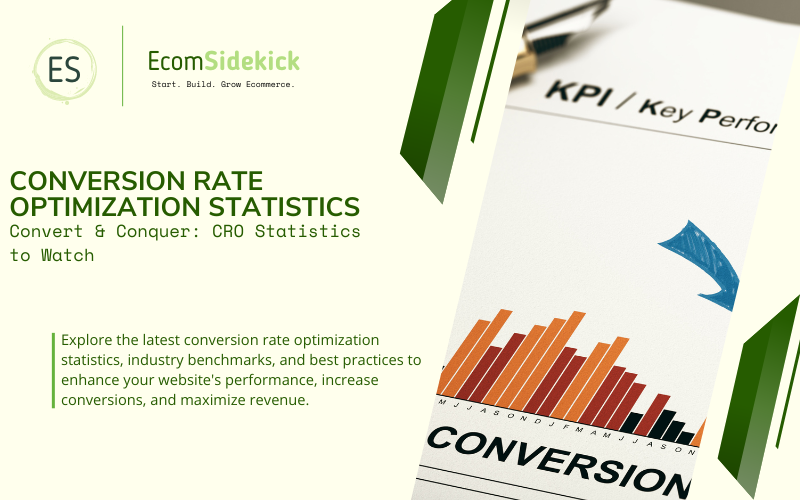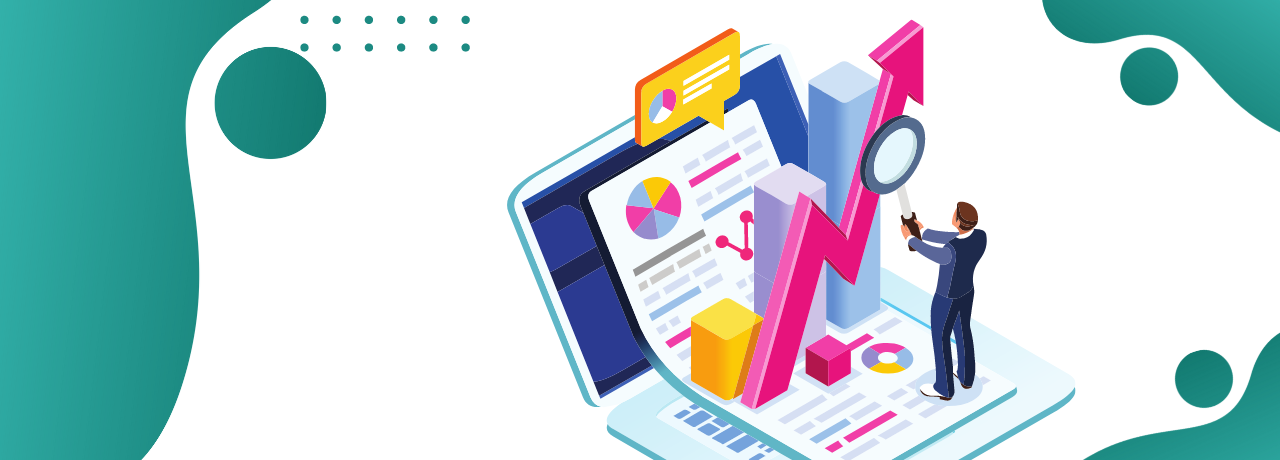In recent times, websites are something that is known to everyone. Some big industries have grown up depending just on websites. Suppose you want to establish your business in 2023. In that case, you need to know what is conversion rate optimization statistics and how it impacts.
A key piece of the ecommerce game is dialing in your landing page conversions and optimizing your funnels.

CRO OR Conversion rate optimization is full of steps that increase the percentage of particular users who act on the website. It adds requesting a quote, including products to the cart, signing up for emails, etc.
Related content: Small Business Profit Stats that Matter
Now, please find out how essential it is to master conversion rate optimization for a well-grown digital marketing strategy with this exciting data.
Conversion Rate Optimization Statistical Details:
The Conversion rate optimization statistics are very worthy of observation. Here we are mentioning the details in points at first. Then you will get the elaborations below.
- The Google Ads search conversion rate increased by 17% on average
- The conversion rate for Search Engine Optimization across all industries is 2.4%
- Landing page conversion rates are around 2.35%
- The United States website conversion rate via tablet for e-commerce was 3.32% on average in Q2 of 2020
- In 2020, media and publishing had an average B2B lead conversion rate of 10%
- The average
- the e conversion rate for all advertisers is between 1.84% and 5.01%
- Online retail has an average conversion rate of 3%
- Inbound marketing increases conversion rates for just an average site from 6% to 12%.
General CRO Statistics:

Conversion rate optimization is essential if a website has minimal visitors who convert. There are numerous reasons why visitors do not make purchases, contact, and subscriptions. Identifying the problem is the initial step in the process that leads to a better zone.
This is where Conversion rate optimization statistics steps in to improve user experience, prices, content and web design, customer satisfaction, and offers. These changes allow website owners to nurture customer loyalty and increase customer retention.
The Average Conversion Rate for Online Retail Is 3% On Average.
The percentage of visitors who purchase can help managers grow their business in any store they manage. The sales numbers and gross revenue are the baselines that every manager needs to be aware of. The retail conversion rate is also essential for calculating a retail store’s performance.
The Shopify Conversion Rate Was Considered 3% On Average.
In July 2023, the survey was conducted on 3,306 Shopify stores. According to the information, a conversion rate of 3.6% usually puts a store in Shopify’s best 20% stores. On the contrary, a conversion rate of 5.1% can put a store as one of the best 10%; however, if the store’s conversion rate on all devices is a minimum of 0.4%, that sets the store in the worst 20%.
(Source: click here)
The Average CRO Is Between 1.84% And 5.01% For All Advertisers.
A conversion rate between these marks means the website is doing quite well. However, the target is to go anywhere over 10%. Many factors, like business, traffic quality, industry, and product, impact conversion rates. Therefore, conversion rate optimization statistics are the best way to find a reasonable conversion rate for specific business and marketing campaigns.
According to the Conversion Rate Optimization Statistics by Industry Data, the Top CRO of Legal Services Is Nearly 6.46%.
There are meaningful discrepancies in conversion rates in different industries. The legalized sector reveals that getting a CRO of nearly 4% is the industry average. In comparison, a CRO of 1% specifies some undetected issues. According to PPC statistics, the PPC conversion rate in this industry was around 6.98% on the search network.
According to the Conversion Rate Optimization Statistics by Industry Data, the Top CRO of Legal Services Is Nearly 6.46%.
There are meaningful discrepancies in conversion rates in different industries. The legalized sector reveals that getting a CRO of nearly 4% is the industry average. In comparison, a CRO of 1% specifies some undetected issues. According to PPC statistics, the PPC conversion rate in this industry was around 6.98% on the search network.
The Landing Page Conversion Rates Are Around 2.35% On Average.
As part of a digital marketing tactic, the landing page naturally represents a standalone page with a single purpose—a follow-up to any promises made in the content. To grow the likelihood of potential consumers ending up on a landing page, it is a good idea to ensure visitors can access through a general search or via the company’s site.
Landing Page Statistics Expose That Addressing Buyers’ Obvious Fears and Reservations on the Page Will Increase the Conversion Rate by 80%.
A landing page solely aims to convince a visitor that providing personal details in exchange for the offers is safe and beneficial. Given that maximum visitors have natural doubts about giving personal information, having a landing page that addresses all these questions will help remove this big obstacle and increase the conversion rate.
The SEO Conversion Rate Across All Industries Is 2.4% On Average.
The success of an SEO strategy is measured with SEO ROI calculation which represents the return on investment. Suppose you’re wondering how to measure ROI on SEO. Marketers must calculate the ROI using a formula (Gain from Investment–Cost of Investment) divided by the Cost of Investment. The result should be multiplied by 100 to get the ROI percentage.
In 2020, the Average B2B Lead Conversion Rate for the Media or Publishing Was 10%.
The lead conversion rate is a key performance indicator that shows the percentage of website visitors who convert to leads, sales, or qualified prospects. B2B benchmarks are a “must-know” before starting a campaign for any industry. It speeds up the decision process, allowing the website to collect data and find alternatives while weighing your options.
Lead Generation Statistics in 2021 Indicate That Spending About 80% Of the Budget on Cold Traffic for Lead Generation Gives Better Results.
A lead is a person who finds a company’s product or service attractive. However, only some people are a lead, given that people have different requests and preferences. Therefore, marketing to everyone can be a huge mistake—this is where lead generation steps in—acquiring new prospects and turning them into potential customers.
Conversion Rate Optimization Statistics Reveal That 17% Of Marketers Use Landing Page A/B Tests to Improve Conversion Rates.
In general, split testing (A/B split testing) compares two versions of a web page or a mobile app and tests them to see which one converts more. Nowadays, A/B split testing is no longer an option, but it’s more than necessary for every digital marketing professional.
Website Conversion Rate Data:
Many website visitors won’t turn into leads since not everyone browses the web to make a purchase. The recent SEO Statistics reveal that mixing SEO and Conversion rate optimization statistics strategies can help get a clearer picture of approaching the targeted audience and increasing the website conversion rate. Moreover, interest in the local market is rising, which is why many apps offer keyword-tracking services. Features like the local tracking by SerpWatch can help understand a website’s local search performance and tap into potential opportunities for growth.
Inbound Marketing Statistics Suggest That 93% Of Buying Cycles Start With an Online Search.
Inbound marketing allows for generating high-quality leads, building momentum for marketing initiatives, and establishing long relationships with customers. This type of marketing is all digital, tracking and measuring all the efforts a business leader makes and evaluating their effectiveness simultaneously.
Inbound Marketing Doubles the Average Site Conversion Rate From 6% To 12%.
Inbound marketing has proven to be a successful tactic that offers customers high-quality and helpful content. This marketing strategy lowers the costs per lead, attracts more information, and, most importantly, increases conversion rates. It also allows testing and checking the effectiveness of any inbound channel, leaving room for actual optimization of conversion rates.
Retargeting Conversion Rate Stats Reveal That 70% Of Website Visitors Who Were Retargeted With Display Ads Were More Likely to Convert.
Even though content marketing and social media are powerful digital marketing strategies, retargeting can also be crucial for campaign success. This digital marketing tactic often succeeds in converting visitors into customers when all other approaches fail. Only 2% of people convert on the first visit. Retargeting is a great way to bring back the additional 98%.
Marketing Optimization Statistics Indicate That One Increase in Ctr in Advertising Is Nearly a 33% Increase.
Click-through rate is the ratio of the public who tap on a hyperlink to the total number of users the link primarily reaches. CTR represents an essential performance measure for evaluating paid advertising, SEO, etc. This metric can increase clicks, increase a website’s search results, and lower advertising costs.
Email Marketing Conversion Rates by Industry Range From 0.31% To 4%.
Email connectivity is an integral part of day-to-day life. Nowadays, it has become the most friendly way to reach targeted audiences. Compared to the other types of digital marketing, email marketing is the most cost-effective channel. It is because social media and postal mail still have a lower median ROI than email.
Ecommerce CRO Facts:

In the case of conversion rate optimization statistics, it is also mentionable that electronic commerce is also known as internet commerce. It refers to using the internet to sell services or goods and transfer money or information. Almost every transaction between customers and businesses can fit into the four main models of e-commerce business—Business to Business, Business to Consumer, Consumer to Consumer, and Consumer to Business.
According to the E-commerce Conversion Rate by Industry Data, Food & Beverage Had the Maximum Speed (5.87%) In April 2021.
These figures show a decrease of 0.91% from March 2021. The food and beverage sectors quickly recovered from the first pandemic attack, reaching the highest conversion rates in the previous year. The multi-brand retail industry had the lowest conversion rate in April, staying at 0.45%—a massive reduction compared to a similar period in 2020.
In Q2 2020, the Average E-commerce Website Conversion Rate via Tablet Was 3.32% In the United States.
In the same quarter, for the other devices, conversion rates were low. Desktop and mobile had similar conversion rates for e-commerce websites (2.1%), while other devices had 0.21%. During Q3 2020, 3.41% of global e-commerce website visitors through tablet devices completed a purchase. However, the desktop CRO was higher than on mobile.
The E-commerce Conversion Rate Was 2.12% In April 2021.
Reasonable e-commerce conversion rates vary between 1% and 2%. For example, 3,000 monthly visitors would bring 30 conversions every month, translating to a 1% conversion rate. Optimizing and analyzing a website’s conversion rate can promote marketing campaigns and give potential customers a good shopping experience.
The Average E-commerce Conversion Rates in April 2021 Were 2.12%.
There are several factors that e-commerce conversion rates depend on, like the market and device the targeted customer uses the most. Data from the last quarter of 2021 indicates that the conversion rate for e-commerce on mobile devices in the United States was lesser than the worldwide average of 1.80%. On the contrary, England’s consumers use their phones to buy with a conversion rate of 2.87%.
Social Media CRO Facts:

The Conversion rate optimization statistics state that social media has taken over the world so fast, becoming the main channel for generating leads. Investing in social media marketing is a good plan considering that consumers spend a lot of time across different platforms. 2021 may be the best year for social e-commerce, given that online shopping has reached its highest rates during the pandemic.
In 2020, the Social Media Conversion Rate Was 0.71% On Average.
Marketing channels and styles are the main factors impacting conversion rate optimization statistics. One of the valuable rules about marketing campaigns is to be subtle but expert. For example, if the targeted people are already converting after the ads on social media, including them in an email campaign might be too much. Also, it might be a good idea to set clear targets before starting a campaign. Even visiting a site can count as a conversion when social media is added.
In Recent Years, the Average Search Conversion Rate for Google Ads Has Increased by 17%.
Unsurprisingly, conversion rates on the search network are higher than on the display network. Visitors have a particular fact on their minds and search for it. Simple browsing will rarely lead to a sale. Nevertheless, it is essential to keep a diverse impact even though it brings a smaller percentage of conversions.
The Facebook Ads Conversion Rate Is Around 9.21% On Average Across All Sectors.
The Facebook ad benchmarks notify that the education industry quickly finds visitors who convert at exceptionally high rates. Other industries with high CRO are fitness, healthcare, B2B, and employment & training. On the other hand, industries like industrial services, travel & hospitality, and technology need help taking advantage of Facebook lead generation ads and increasing the number of leads and conversion rates.
CRO Statistics for 2023:
Many marketers spend countless hours on campaigns by researching customers and analyzing their needs. There’s a lot of work going into the marketing process. However, the end goal is to optimize your website and campaigns for conversions. A successful marketing strategy requires good planning and combining all the available resources. After preparing a good marketing approach and getting the attention of the targeted audience, it is vital to include a good conversion rate optimization for building revenue. These conversion rate optimization statistics will give you an idea of how other businesses establish conversion rates to stay on top of the list.
Final Thoughts
CRO’s direct benefits include more vital trust, a better user experience, higher scalability, improved ROI, and enhanced customer insights. You must know where to optimize, what to optimize, and whom to optimize. Conversion rate optimization statistics can help you achieve higher sales, lower customer acquisition costs, and increased turnover.
And even though there is no recipe for sure success, our list of the most effective CRO statistics is a good starting point for you to start building your profitable online business. At last, there is nothing better than hard facts and figures to guide your way on what you should or should not do.
Frequently Asked Question
What Is Conversion Rate Optimization (CRO), and Why Is It Important for Businesses?
Conversion rate optimization (CRO) is the process of improving the percentage of website visitors who take a desired action, such as making a purchase, signing up for a newsletter, or filling out a form. CRO is crucial for businesses as it helps maximize the return on investment (ROI) from existing website traffic. By increasing the conversion rate, businesses can effectively turn more visitors into customers or leads without necessarily attracting more traffic.
What Are the Common Barriers to Conversion and How Can They Be Addressed?
Common barriers to conversion include unclear messaging, complicated forms, lack of trust, and poor user experience. To address these barriers, businesses should focus on improving website navigation, providing transparent pricing and return policies, using persuasive copywriting, and simplifying the conversion process. Conducting user testing and gathering feedback can also help identify and address potential barriers.
How Can Businesses Measure the Success of Their CRO Efforts?
Businesses can measure the success of their CRO efforts by tracking key performance indicators (KPIs) such as conversion rate, bounce rate, time on page, and click-through rates. Using tools like Google Analytics and other CRO-specific platforms can provide valuable insights into website performance and the impact of optimization efforts.
Paul Martinez is the founder of EcomSidekick.com. He is an expert in the areas of finance, real estate, eCommerce, traffic and conversion.
Join him on EcomSidekick.com to learn how to improve your financial life and excel in these areas. Before starting this media site, Paul built from scratch and managed two multi-million dollar companies. One in the real estate sector and one in the eCommerce sector.

